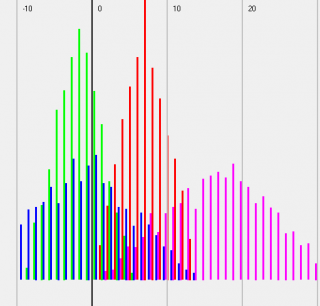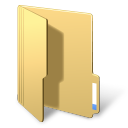Leaderboard
Popular Content
Showing content with the highest reputation on 05/14/2018 in Posts
-

Scrollbars Made Easy - New version 27 Jan 22
pixelsearch reacted to Melba23 for a topic
[New Version] - 27 Jan 22 New: The GUIScrollbar_Ex UDF now recognises Win-D and taskbar desktop clearance commands and runs the correct minimize/restore code automatically. The previous UDF _Minimize and _Restore commands have been superceded by a single _EventMonitor function which runs in the script idle loop. This is a script-breaking change, but I hope that the additional functionality is worth the small effort it will take to alter your scripts. New UDFs, examples in zip file below. Previous changes: Changelog.txt Are you bemused by scrollbars? > Do you find them too difficult to use? > Then you need the GUIScrollbars_Ex UDF! Just download the zip at the end of the post and run this short script with the UDF in the same folder. No tricky calculations, no complicated functions to master - just easy to use, accurate scrollbars with one command! [size=5]#include <guiconstantsex.au3> #include "GUIScrollbars_Ex.au3" ; Create GUI with red background $hGUI = GUICreate("Test", 500, 500) GUISetBkColor(0xFF0000, $hGUI) ; Create a 1000x1000 green label GUICtrlCreateLabel("", 0, 0, 1000, 1000) GUICtrlSetBkColor(-1, 0x00FF00) GUISetState() ; Generate scrollbars - Yes, this is all you need to do!!!!!!!!!!!!!!!!!!!! _GUIScrollbars_Generate($hGUI, 1000, 1000) While 1 Switch GUIGetMsg() Case $GUI_EVENT_CLOSE Exit EndSwitch WEnd[/size] Try it today and see how easy it is! I have been trying for some time to understand how scrollbars work and how to get them closely to match the area I want to display. After much research and headscratching I have come up with 2 UDFs which I hope will be of use to others. Apologies for the length of this post, but scrollbars are complex beasts and as I did this mainly for the less experienced user I want to make sure that they understand what is going on. The 2 UDFs are: GUIScrollbars_Ex.au3 - This gives you scrollbars sized to your GUI in one simple command - with no other includes or commands needed. The UDF is designed for those who would not normally use scrollbars because the whole process looks too complicated. It also includes a command to enable you to scroll page by page, thus making it easy to scroll to anywhere on the GUI with only simple calulations based on the values you used to create the GUIs. [New] Ability to have recalculated scrollbars on resizeable GUIs. GUIScrollbars_Size.au3 - This calculates the Page and Max numbers for the user to feed into the _GUIScrollbar_SetScrollInfoPage/Max commands. The UDF is aimed at the more experienced user and is particularly useful when you have a GUI with a dynamic scroll size (i.e. adding or subtracting controls to the scrollable area as the script runs). First, a short tutorial for those who are interested in how the scrollbars affect your GUI and what it is that the UDFs calculate: All the files mentioned here are in a downloadable zip file at the end of the post. GUIScrollbars_Size.au3 As mentioned previously, the GUIScrollbars_Size.au3 UDF is aimed at the more experienced user who wants to use the full range of _GUIScrollbar comands, but would like a quick way of getting the required Page and Max values. It uses no other include files so you will need to include GUIScrollbars.au3 yourself, as well as the necessary GUIRegisterMsg and procedures for WM_VSCROLL and WM_HSCROLL. The syntax is simple - the size of the scrollable GUI and either the handle of the GUI you have created to hold the scrollbars or the size of the one you are going to create. It returns a 6-element array including the Page and Max values for the scrollbars and factors to compensate for the "shrinkage" of the GUI if you had already drawn some controls and wished to add others. Of interest, the returned Max value is biased not to clip the edges of the GUI - reducing it by 1 makes a tighter fit but can lead to some clipping. (If that does not make sense, please see the tutorial above for more details) The Size_Example_1 script to show the UDF in action - the "Pass Size" button shows the effect of creating the scrollbars BEFORE the controls, the "Pass Handle" button shows what happens if the scrollbars are created AFTER the controls. If you do not understand why there is a difference - go and read the tutorial above ! You will need to have the GUIScrollbar_Size.au3 UDF in the same folder. Where this UDF really helps is if you have a scrollable GUI of variable size - if the number of controls varies with user selections for example. All you need to do is to rerun the UDF with the new size of the scrollable GUI and it produces a new Max value for you to use. The Size_Example_2 script shows how the function enables you to dynamically size your scrollbars depending on the number of controls required. As before it requires the GUIScrollbar_Size.au3 UDF in the same folder. -------- Now the "simple" GUIScrollbars_Ex.au3 (which is actually the more complex internally as you would expect). This UDF is intended to be the single point of call for creating scrollbars on a GUI - it will automatically add the GUIScrollbars UDF and the WM_VSCROLL and WM_HSCROLL GUIRegisterMsg commands and procedures to your script - so you need no commands other than those within the UDF itself. These commands are _GUIScrollbars_Generate and _GUIScrollbars_Scroll_Page. As you might expect, _GUIScrollbars_Generate generates scrollbars for your GUI. It is usually called AFTER you have added all the controls and all you need to use it is the GUI handle and the size of the underlying GUI you want to scroll. If you so wish, you can also decide to generate the scrollbars BEFORE the controls on the scrollable GUI, and you can choose if you want to risk not quite reaching the edge of the GUI when the scrollbars are at the maximum position. So a basic call could be as simple as: _GUIScrollbars_Generate ($hGUI, 1000, 1000) which would put scrollbars on the $hGUI window allowing a 1000x1000 underlying GUI to be displayed. _GUIScrollbars_Scroll_Page lets you scroll a page at a time. If your GUI was 200 pixels wide, you would have 1000/200 = 5 pages to scroll before reaching the edge - no need to know what the actual Page and Max values are, just use this simple division based on the number you use to draw the GUIs. So: _GUIScrollbars_Scroll_Page ($hGUI, 3) would scroll to the third page - it would display the area between 400 and 600 pixels of the full 1000 pixel width. If you ask for a page over the maximum available, you just scroll to the maximum position - asking for page 1 resets you to the origin. Ex_Example_1 shows the UDF working. You can decide whether to have both or just one scrollbar, whether to create the scrollbars before or after the controls, and whether you want the maximum scroll to be tight to the edge or leave a border. Just select the options you want - the script selects a random width and height for both the scrollbar GUI and the underlying GUI - and press the "Scroll" button to show a single page scroll down and/or right followed by a scroll to the bottom right corner of the GUI. There are labels to let you see the size of the GUI and the accuracy of the page scrolls (please read the tutorial above to understand why these are almost certainly inaccurate). The script requires the GUIScrollbars_Ex.au3 UDF in the same folder. Ex_Example_2 is a really simple example to show how easy generating scrollbars can now become! As you can see - no other includes, no GUIRegisterMsg commands, no WM_H/VSCROLL procedure functions. Just accurate scrolling and proportional thumb sizes. Ex_Example_3 shows the automatic calculation of control positions. Ex_Example_4 shows how to initiate the cursor keys to scroll the GUI as well. [New] Ex_Example_5 shows how to use the new _GUIScrollbarsEx_Resizer function. I hope these 2 UDFs are useful to AutoIt users - I certainly find them so. Here is a zip file with the UDFs and examples: Scrollbars.zip My grateful thanks to the authors of the GUIScrollbars and WinAPI UDFs for their code, some of which I have plundered. And as always I welcome constructive criticism and/or effusive congratulations. M231 point -

Need all DeviceCaps parameter values
Earthshine reacted to jguinch for a topic
No, I don't use this in my UDF. For all values, open a search engine, and search for "define HORZRES" (for example). By chance, you will have an link to C header (link this one : http://www.rensselaer.org/dept/cis/software/g77-mingw32/include/wingdi.h )1 point -
3.5.4 isn't the AutoIt version number, it's the SciTE version number. Run this script and tell us what the results are: #include <Misc.au3> ; Version: 1.00. AutoIt: V3.3.8.1 ; Retrieve the recommended information of the current system when posting a support question. Local $sSystemInfo = 'I have a valid AutoIt support question and kindly provided the details of my system:' & @CRLF & @CRLF & _ 'AutoIt Version: V' & @AutoItVersion & ' [' & (@AutoItX64 ?'X64':'X32') & ']' & @CRLF & _ 'Windows Version: ' & @OSVersion & ' [' & @OSArch & ']' & @CRLF & _ 'Language: ' & _GetOSLanguage() & ' (' & @OSLang & ')' & @CRLF & @CRLF MsgBox(4096, 'This info has been copied to the clipboard. Use Ctrl + V to retrieve it.', $sSystemInfo) ClipPut($sSystemInfo) Func _GetOSLanguage() Local $aString[20] = [19, "0409 0809 0C09 1009 1409 1809 1C09 2009 2409 2809 2C09 3009 3409", "0404 0804 0C04 1004 0406", "0406", "0413 0813", "0425", _ "040B", "040C 080C 0C0C 100C 140C 180C", "0407 0807 0C07 1007 1407", "040E", "0410 0810", _ "0411", "0414 0814", "0415", "0416 0816", "0418", _ "0419", "081A 0C1A", "040A 080A 0C0A 100A 140A 180A 1C0A 200A 240A 280A 2C0A 300A 340A 380A 3C0A 400A 440A 480A 4C0A 500A", "041D 081D"] Local $aLanguage[20] = [19, "English", "Chinese", "Danish", "Dutch", "Estonian", "Finnish", "French", "German", "Hungarian", "Italian", _ "Japanese", "Norwegian", "Polish", "Portuguese", "Romanian", "Russian", "Serbian", "Spanish", "Swedish"] For $i = 1 To $aString[0] If StringInStr($aString[$i], @OSLang) Then Return $aLanguage[$i] EndIf Next Return $aLanguage[1] EndFunc ;==>_GetOSLanguage Paste the contents of the clipboard to your post, this script puts the information into the clipboard for you.1 point
-

Capturing the Name of a Variable
Earthshine reacted to junkew for a topic
You can also assign a function to a variable and with that you can more or less wrap your function1 point -
Your welcome. It only keeps the computer from going to sleep while the process is running. Another option is to use Task Scheduler, and create a task to run at the needed times. There is an option under the Conditions tab to "Wake the computer to run this task" in the Create Task dialog box. Adam1 point
-
Capturing the Name of a Variable
Earthshine reacted to OldGuyWalking for a topic
Thanks for the responses. JPM - Thank you. I'll look at Assign and Eval again. I'd looked at them before but they didn't seem to fit what I was looking for but will reread. Earthshine - I agree. I use various #include files, including a few that I've built, and writing to logs is the only way I've found I can locate some logic errors in code when the app jumps in and out of multiple functions across several include files. OldGuyWalking1 point -
Have a look at _WinAPI_SetThreadExecutionState. #include <WinAPIProc.au3> ;Enable away mode and prevent the sleep idle time-out. _WinAPI_SetThreadExecutionState(BitOR($ES_CONTINUOUS, $ES_SYSTEM_REQUIRED, $ES_AWAYMODE_REQUIRED)) ;Wait until process is complete... ;Clear EXECUTION_STATE flags to disable away mode and allow the system to idle to sleep normally. _WinAPI_SetThreadExecutionState($ES_CONTINUOUS) Adam1 point
-
You are calling _AD_IsMemberOf incorrectly. The group name is the first parameter, and the user name is the second. Adam1 point
-
Capturing the Name of a Variable
Earthshine reacted to jpm for a topic
the only thing you can do is pass the variable name as a string and in the func use $aArray = Eval($sVarname) Edited Execute wrong Eval better1 point -

What happened to "Compile with Options"?
DynamicRookie reacted to Jos for a topic
Is there a question in your reply to this 7 years old thread? Jos1 point -

New MVPs
FrancescoDiMuro reacted to Melba23 for a topic
Hi, Some good news today: Danp2, RTFC and junkew have accepted the invitation to become MVPs. I am sure you will all join me in congratulating them on their new status. M231 point -

Amending the FAQ in the help file.
DynamicRookie reacted to Zedna for a topic
Q: How can I test if checkbox/radiobutton is checked? A: Use this small function: If IsChecked($checkbox1) Then ... Func IsChecked($control) Return BitAND(GUICtrlRead($control), $GUI_CHECKED) = $GUI_CHECKED EndFunc This question was asked/answered really many many times. Probably function IsChecked($control) could be added to AutoIt as native function because it's basic functionality of GUI1 point -
tarretarretarre, Here here here is all what you need need need. The key point is that the structure of a treeview is uniquely defined by the levels of the items. When you have figured that out, the rest is easy. This code creates a more or less random treeview, and writes the structure to a disk file, TreeView.txt. #include <GUIConstants.au3> #include <WindowsConstants.au3> #include <GuiTreeView.au3> #include <Array.au3> #include <File.au3> Global $hTV Example() Func Example() ; Create GUI Local $hGui = GUICreate( "Save TreeView to file", 400, 350, 600, 300, $GUI_SS_DEFAULT_GUI ) ; Create TreeView Local $idTV = GUICtrlCreateTreeView( 4, 4, 392, 292, $GUI_SS_DEFAULT_TREEVIEW, $WS_EX_CLIENTEDGE ) $hTV = GUICtrlGetHandle( $idTV ) ; Add items Local $hItem0 = _GUICtrlTreeView_Add( $hTV, 0, 0 ) _GUICtrlTreeView_AddChild( $hTV, $hItem0, 1 ) _GUICtrlTreeView_AddChild( $hTV, $hItem0, "This" ) Local $hItem3 = _GUICtrlTreeView_AddChild( $hTV, $hItem0, "is" ) _GUICtrlTreeView_AddChild( $hTV, $hItem3, 4 ) _GUICtrlTreeView_AddChild( $hTV, $hItem3, "a" ) _GUICtrlTreeView_AddChild( $hTV, $hItem3, "very" ) Local $hItem7 = _GUICtrlTreeView_AddChild( $hTV, $hItem3, "nice" ) _GUICtrlTreeView_AddChild( $hTV, $hItem7, 8 ) _GUICtrlTreeView_AddChild( $hTV, $hItem7, "TreeView" ) Local $hItem10 = _GUICtrlTreeView_Add( $hTV, $hItem0, ", (comma)" ) _GUICtrlTreeView_AddChild( $hTV, $hItem10, 11 ) _GUICtrlTreeView_AddChild( $hTV, $hItem10, "indeed." ) _GUICtrlTreeView_Add( $hTV, $hItem0, 13 ) ; Expand TreeView _GUICtrlTreeView_Expand( $hTV, $hItem0 ) _GUICtrlTreeView_Expand( $hTV, $hItem10 ) ; Create button Local $idButSave = GUICtrlCreateButton( "Save", 160, 310, 80, 30 ) ; Show GUI GUISetState( @SW_SHOW, $hGui ) ; Message loop While 1 Local $iMsg = GUIGetMsg() If $iMsg = 0 Or $iMsg = $GUI_EVENT_MOUSEMOVE Then ContinueLoop Switch $iMsg Case $idButSave SaveTreeView() Case $GUI_EVENT_CLOSE ExitLoop EndSwitch WEnd GUIDelete( $hGui ) Exit EndFunc Func SaveTreeView() Local $aLines[100][2], $iLines = 0 Local $hItem = _GUICtrlTreeView_GetFirstItem( $hTV ) ; Get structure and information While $hItem $aLines[$iLines][0] = _GUICtrlTreeView_Level( $hTV, $hItem ) ; The level decides the structure $aLines[$iLines][1] = _GUICtrlTreeView_GetText( $hTV, $hItem ) ; The text is the information $hItem = _GUICtrlTreeView_GetNext( $hTV, $hItem ) $iLines += 1 WEnd ReDim $aLines[$iLines][2] _ArrayDisplay( $aLines ) ; Save structure and information _FileWriteFromArray( "TreeView.txt", $aLines ) EndFunc This code reads TreeView.txt, and recreates the treeview from the structure. #include <GUIConstants.au3> #include <WindowsConstants.au3> #include <GuiTreeView.au3> #include <Array.au3> #include <File.au3> Global $hTV Example() Func Example() ; Create GUI Local $hGui = GUICreate( "Create TreeView from file", 400, 350, 600, 300, $GUI_SS_DEFAULT_GUI ) ; Create TreeView Local $idTV = GUICtrlCreateTreeView( 4, 4, 392, 292, $GUI_SS_DEFAULT_TREEVIEW, $WS_EX_CLIENTEDGE ) $hTV = GUICtrlGetHandle( $idTV ) ; Create button Local $idButCreate = GUICtrlCreateButton( "Create", 160, 310, 80, 30 ) ; Show GUI GUISetState( @SW_SHOW, $hGui ) ; Message loop While 1 Local $iMsg = GUIGetMsg() If $iMsg = 0 Or $iMsg = $GUI_EVENT_MOUSEMOVE Then ContinueLoop Switch $iMsg Case $idButCreate CreateTreeView() Case $GUI_EVENT_CLOSE ExitLoop EndSwitch WEnd GUIDelete( $hGui ) Exit EndFunc Func CreateTreeView() ; Delete TreeView _GUICtrlTreeView_DeleteAll( $hTV ) ; Read structure and information Local $aLines, $iLines _FileReadToArray( "TreeView.txt", $aLines, 0 ) $iLines = UBound( $aLines ) _ArrayDisplay( $aLines ) ; Create TreeView structure and information Local $aLine, $aLevels[100], $iLevel, $iLevelPrev = 0, $hItem ; Add root $aLine = StringSplit( $aLines[0], "|", 2 ) $hItem = _GUICtrlTreeView_Add( $hTV, 0, $aLine[1] ) $aLevels[0] = $hItem ; $aLevels[$iLevel] contains the last item of that level For $i = 1 To $iLines - 1 $aLine = StringSplit( $aLines[$i], "|", 2 ) $iLevel = $aLine[0] If $iLevel <> $iLevelPrev Then If $iLevel > $iLevelPrev Then ; A child of the previous level $hItem = _GUICtrlTreeView_AddChild( $hTV, $aLevels[$iLevelPrev], $aLine[1] ) Else ; $iLevel < $iLevelPrev ; A sibling of the level $hItem = _GUICtrlTreeView_Add( $hTV, $aLevels[$iLevel], $aLine[1] ) EndIf $aLevels[$iLevel] = $hItem ; $aLevels[$iLevel] contains the last item of that level $iLevelPrev = $iLevel Else ; $iLevel = $iLevelPrev ; A sibling of the level $hItem = _GUICtrlTreeView_Add( $hTV, $aLevels[$iLevel], $aLine[1] ) $aLevels[$iLevel] = $hItem ; $aLevels[$iLevel] contains the last item of that level EndIf Next _GUICtrlTreeView_Expand( $hTV ) EndFunc1 point






